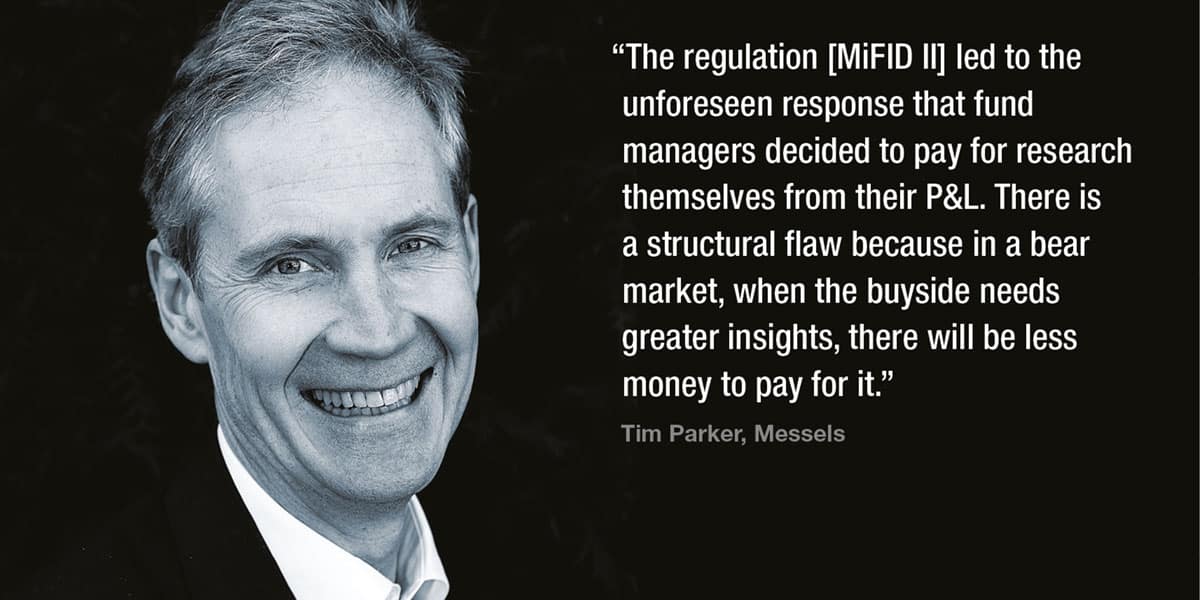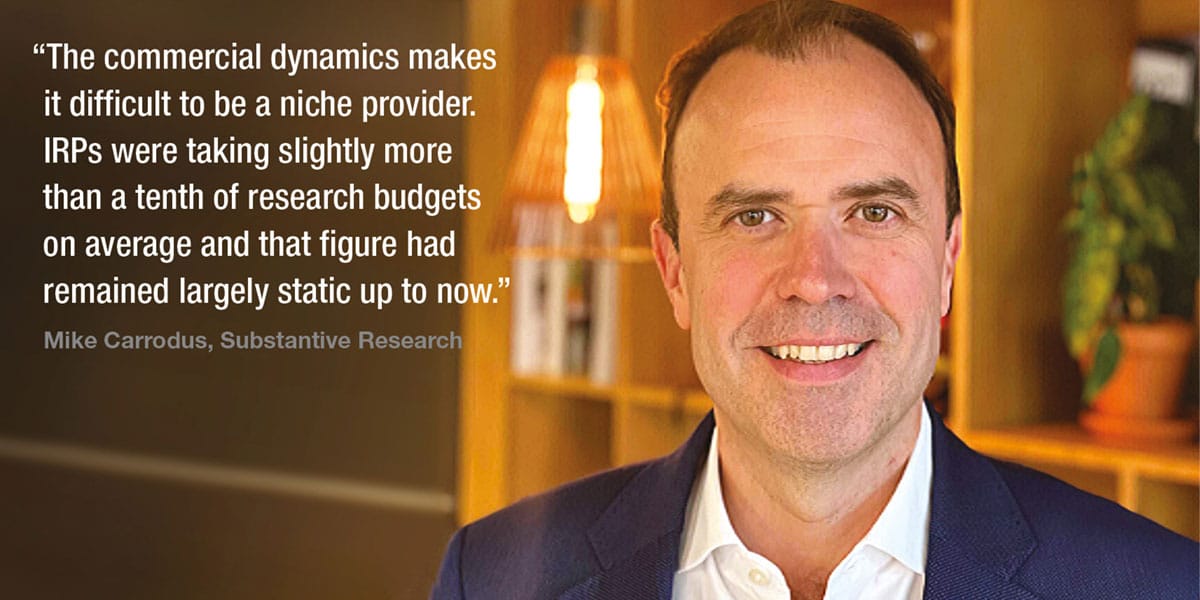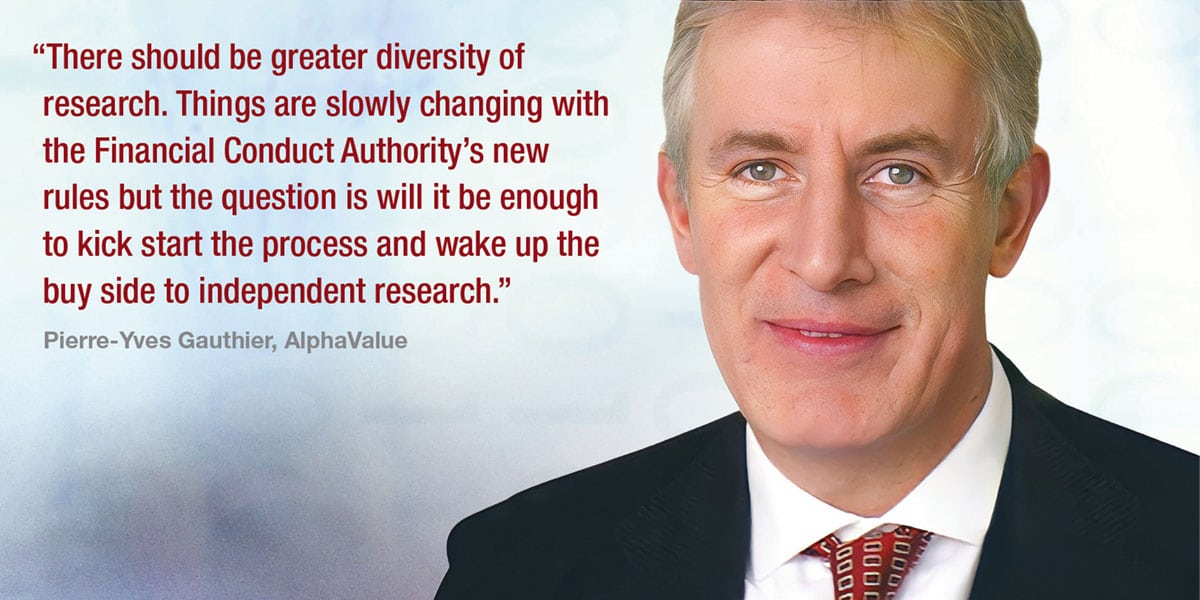Lynn Strongin Dodds looks at why independent research providers (IRP) have not gained the foothold expected after MiFID II.
Although MiFID II was supposed to usher in a new era of research, the bulge bracket banks continue to dominate the investment scene and the independents are still struggling to get a foothold. The picture is not expected to change as the pie is getting even smaller with asset managers tightening their belts even further due to the current economic turbulence.

“Independent research firms have made little progress since MiFID II came into force in 2017,” says Tim Parker of Messels Ltd, which opened its doors in 2000. “The regulation led to the unforeseen response that fund managers decided to pay for research themselves from their P&L. There is a structural flaw because in a bear market, when the buyside needs greater insights, there will be less money to pay for it.”
Steve Kelly, special adviser at Euro IRP, the European Association of Independent Research Providers, which represents the interests of independent firms, agrees, adding that one of the fundamental aims of regulators in developing the MiFID II rulebook was that it would pave the way for a more level playing field in the investment research market. By separating provision of research services from trading/execution services, then the thinking was research would stand or fall on its own merits, and be priced accordingly.

“Quality, diversity and independent thinking would be highly prized, and the flood of sub-standard, ‘me-too’ research would reduce to a trickle,” he adds. ‘All this would create a far broader research ecosystem, and one that best served both institutional investors, and their ultimate clients.
Kelly notes it wasn’t just the regulators that had this view but also the research platforms who set up ready to welcome the new incumbents. “However, there is less research than before MiFID II, and several providers have either exited the market, or significantly scaled back operations, but the overall market share mix is very much as before,” he adds. “Indeed, whilst asset managers usually take research from fewer bulge bracket houses than before, the bulge bracket share of the research wallet has grown, especially over the last year.”
The numbers speak for themselves. A recent buy-side study on investment research by Substantive Research, a research curation, comparison and valuation provider, shows that in fact the market is much less competitive, and specialist, while differentiated research has become less available in times of heightened volatility. Surveying 40 asset managers across Europe and the US with AUM of between $2bn and $800bn, it revealed that regulation has not altered the landscape and provision is still concentrated.
The report showed that in 2019, 52% of research budgets went to the top 10 providers, compared with 51.6% in 2020, only to increase to 53.1% in 2021. This means that the incumbents are actually getting more powerful and that competition has decreased due to MiFID II.
Squeezed wallets
Research budgets also decreased once again year on year – with US wallets dropping by the same 11 percentage points as their European counterparts for the first time. The drivers are different, according to the report. European fund managers having to dig deeper into their pockets are feeling the heat while in the US buy side firms are looking for more efficient, mutually valued relationships with a core list that is still longer and better rewarded than the European counterparts.

“The commercial dynamics makes it difficult to be a niche provider,” says Mike Carrodus founder of Substantive Research, “IRPs were taking slightly more than a tenth of research budgets on average and that figure had remained largely static up to now.”
One reason is that it is difficult to be competitive with the bulge brackets who have the deep pockets and resources to generate a greater depth and breadth of research. As Kelly notes, the large investment banks, and sell side brokers also offering execution and/or corporate finance services, have provided core access to their research at very aggressive prices.
The most common example often quoted, he says is that JP Morgan offers all equity research globally at $10,000 per annum “However, there are many others like this, where essentially research is being given away effectively for free,” he adds. “Banks and brokers have done this partly because they can; they can afford to carry the cost, and they have not been hit by regulatory reaction even though MiFID II rules carry that threat.
Kelly also notes that banks would assert they need to produce research for their own internal purposes, and for their own asset management arms; and as well they have a great number of clients, so they can legitimately apply low units’ costs.
“The main reason here is the simple reality that for investment banks & the sell side in general, research has always been the route in to build, develop and sustain client relationships,’ he adds. “And through those relationships, then win business across execution, financing and other highly lucrative services. MiFID II didn’t change that. Ironically, given what was said earlier, you can argue it’s even accentuated it.”
The bottom line, according to Pierre-Yves Gauthier, head of strategy at AlphaValue, a Paris-based independent research firm, is that the larger firms slashed prices and undercut the independents. “There should be greater diversity of research” he says. “Things are slowly changing with the Financial Conduct Authority’s new rules but the question is will it be enough to kick start the process and wake up the buy side to independent research.”

Lack of true reforms
Yves-Gauthier is not alone and many other independent providers believe that the FCA could be much more proactive. Last year, the UK regulator implemented reforms that would allow small and mid-cap listed or unlisted companies (SMEs) that have a market capitalisation below £200 million to be exempt from the rules. This means that research could be provided by brokers to asset managers on a bundled basis.
The changes are not enough to move the needle for the independent providers but the UK watchdog has had to tread carefully given it was the main architect of unbundling for the MiFID II mandate and it did not want to appear to be back peddling. Unbundling was not popular with French and German authorities who wanted to keep the status quo. The FCA contends that this low level is where the research coverage is at its poorest, based on data indicating that almost all companies above this threshold have some form of coverage already.
Most disagree with this perspective. The one area where some see opportunities is the provision of environmental, social and governance (ESG) research. The Substantive study found that there was increasing spend on ESG research specialists. It has doubled over the past three years although it started from a small base. It currently accounts for just under 1% of the average research budget, up from 0.47% to 0.95% of the average research budget from 2019-2021.
To date, asset managers have concentrated their spend on ESG data rather than on external research, and the focus has been on core brokers’ coverage on names in renewable energy and electric vehicles. However, as Carrodus notes, “there is a drive to gather assets and there is an opportunity to help fund managers navigate messages from data and find insights. However, at the moment, it is about timing because the budgets are not yet being allocated to specialist ESG research.”
©Markets Media Europe 2022
